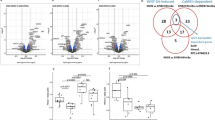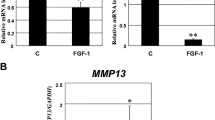Abstract
Knowledge of the microenvironment of articular cartilage in health and disease is the key to accomplishing fundamental disease-modifying treatments for osteoarthritis. The proteins comprising the CCN Family are matricellular proteins with a remarkable relevance within the context of cartilage metabolism. CCN2 displays a great capability for regenerating articular cartilage, and CCN3 has been shown to activate the expression of genes related to articular chondrocytes and to repress genes related to endochondral ossification in epiphyseal chondrocytes. Moreover, mice lacking CCN3 protein have been shown to display ostearthritic changes in their knee articular cartilage. In this study, we employed a monoiodoacetic acid (MIA)-induced osteoarthritic model to investigate whether osteoarthritic changes in the cartilage are reciprocally accompanied by CCN3 down-regulation and an inducible overexpression system to evaluate the effects of CCN3 on articular chondrocytes in vitro. Finally, we also investigated the effects of exogenous CCN3 in vivo during the early stages of MIA-induced osteoarthritis. We discovered that CCN3 is expressed by articular chondrocytes in normal rat knees, whereas it is rapidly down-regulated in osteoarthritic knees. In vitro, we also discovered that CCN3 increases the proteoglycan accumulation, the gene expression of type II collagen, tenascin-C and lubricin, as well as the protein production of tenascin-C and lubricin in articular chondrocytes. In vivo, it was discovered that exogenous CCN3 increased tidemark integrity and produced an increased production of lubricin protein. The potential utility of CCN3 as a future therapeutic agent and possible strategies to improve its therapeutic functions are also discussed.






Similar content being viewed by others
References
Koyama E, Shibukawa Y, Nagayama M, Sugito H, Young B et al (2008) A distinct cohort of progenitor cells participates in synovial joint and articular cartilage formation during mouse limb skeletogenesis. Dev Biol 316:62–73
Saito T, Kawaguchi H (2010) HIF-2α as a possible therapeutic target of osteoarthritis. Osteoarthritis Cartilage 18:1552–1556
Brigstock DR (2003) The CCN family: a new stimulus package. J Endocrino 178:169–175
Perbal B (2004) CCN proteins: multifunctional signalling regulators. Lancet 363:62–64
Perbal B, Takigawa M (eds) (2005) CCN proteins–a new family of cell growth and differentiation regulators. Imperial College Press, London, pp 1–311
Chen CC, Lau LF (2009) Functions and mechanisms of action of CCN matricellular proteins. Int J Biochem Cell Biol 41:771–783
Kubota S, Takigawa M (2013) The CCN family acting throughout the body: recent research developments. Biomol Concepts 4:477–494
Kawaki H, Kubota S, Suzuki A, Lazar N, Yamada N et al (2008) Cooperative regulation of chondrocyte differentiation by CCN2 and CCN3 shown by a comprehensive analysis of the CCN family proteins in cartilage. J Bone Miner Res 23:1751–1764
Nishida T, Kubota S, Kojima S, Kuboki T, Nakao K et al (2004) Regeneration of defects in articular cartilage in rat knee joints by CCN2 (connective tissue growth factor). J Bone Miner Res 19:1308–1319
Abd El Kader T, Kubota S, Nishida T, Hattori T, Aoyama E et al (2014) The regenerative effects of CCN2 independent modules on chondrocytes in vitro and osteoarthritis models in vivo. Bone 59:180–188
Janune D, Kubota S, Nishida T, Kawaki H, Perbal B et al (2011) Novel effects of CCN3 that may direct the differentiation of chondrocytes. FEBS Lett 585:3033–3040
Pacifici M, Iwamoto M, Golden EB, Leatherman JL, Lee YS et al (1993) Tenascin is associated with articular cartilage development. Dev Dyn 198:123–134
Pacifici M (1995) Tenascin-C and the development of articular cartilage. Matrix Biol 14:689–698
Roddy KA, Boulter CA (2015) Targeted mutation of NOV/CCN3 in mice disrupts joint homeostasis and causes osteoarthritis-like disease. Osteoarthritis Cartilage 24:607–615
Cary LC, Goebel M, Corsaro BG, Wang HG, Rosen E et al (1989) Transposon mutagenesis of baculoviruses: analysis of Thrichoplusia ni transposon IFP2 insertions within the FP-locus of nuclear polyhedrosis viruses. Virology 172:156–169
Fraser MJ, Cary L, Boonvisudhi K, Wang HG (1995) Assay for movement of Lepidopteran transposon IFP2 in insect cells using a baculovirus genome as target DNA. Virology 211:397–407
Weber K, Bartsch U, Stocking C, Fehse B (2008) A multicolor panel of novel lentiviral “gene ontology” (LeGO) vectors for functional gene analysis. Mol Ther 16:698–706
Abd El Kader T, Kubota S, Janune D et al (2013) Anti-fibrotic effect of CCN3 accompanied by altered gene expression profile of the CCN family. J Cell Commun Signal 7:11–18
Tabata Y, Nagano A, Muniruzzaman M, Ikada Y (1998) In vitro sorption and desorption of basic fibroblast growth factor from biodegradable hydrogels. Biomaterials 19:1781–1789
Yamamoto M, Tabata Y, Hong L, Miyamoto S, Hashimoto N et al (2000) Bone regeneration by transforming growth factor beta1 released from a biodegradable hydrogel. J Control Release 64:133–142
Li Z, Michael IP, Zhou D, Nagy A, Rini JM (2013) Simple piggyBac transposon-based mammalian cell expression system for inducible protein production. Proc Natl Acad Sci USA 110:5004–5009
Jay GD, Waller KA (2014) The biology of lubricin: near frictionless joint motion. Matrix Biol 39:17–24
Okamura N, Hasegawa M, Nakoshi Y, Iino T, Sudo A et al (2010) Deficiency of tenascin-C delays articular cartilage repair in mice. Osteoarthritis Cartilage 18:839–848
von der Mark K, Kirsch T, Nerlich A, Kuss A, Weseloh G et al (1992) Type X collagen synthesis in human osteoarthritic cartilage. Indication of chondrocyte hypertrophy. Arthritis Rheum 35:806–811
Kempson G. (1980) The mechanical properties of articular cartilage. In: Sokoloff L (ed.) The Joints and Synovial Fluid. Academic Press Inc. Volume 2., New York, USA, p 238–239
Schmidt MB, Mow VC, Chun LE, Eyre DR (1990) Effects of proteoglycan extraction on the tensile behaviour of articular cartilage. J Orthop Res 8:353–363
Chevalier X, Groult N, Larget-Piet B, Zardi L, Hornebeck W (1994) Tenascin distribution in articular cartilage from normal subjects and from patients with osteoarthritis and rheumatoid arthritis. Arthritis Rheum 37:1013–1022
Chockalingam PS, Glasson SS, Lohmander LS (2013) Tenascin-C levels in synovial fluid are elevated after injury to the human and canine joint and correlate with markers of inflammation and matrix degradation. Osteoarthritis Cartilage 21:339–345
Ikemura S, Hasegawa M, Iino T, Miyamoto K, Imanaka-Yoshida K, Yoshida T, Sudo A (2015) Effect of tenascine-C on the repair of full-thickness osteochondral defects of articular cartilage in rabbits. J Orthop Res 33:567–571
Kawaguchi H (2008) Endochondral ossification signals in cartilage degradation during osteoarthritis progression in experimental mouse models. Mol Cells 25:1–6
Jay GD, Torres JR, Rhee DK, Helminen HJ, Hytinnen MM et al (2007) Association between friction and wear in diarthrodial joints lacking lubricin. Arthritis Rheum 56:3662–3669
Koyama E, Saunders C, Salhab I, Decker RS, Chen I et al (2014) Lubricin is required for the structural integrity and post-natal maintenance of TMJ. J Dent Res 93:663–670
Hill A, Duran J, Purcell P (2014) Lubricin protects the temporomandibular joint surfaces from degeneration. PLoS ONE 9(9):e106497
Kosinska MK, Ludwig TE, Liebisch G, Zhang R, Siebert HC et al (2015) Articular joint lubricants during osteoarthritis and rheumatoid arthritis display altered levels and molecular species. PLoS One 10:e0125192
Elsaid KA, Machan JT, Waller K, Fleming BC, Jay GD (2009) The impact of anterior cruciate ligament injury on lubricin metabolism and the effect of inhibiting tumor necrosis factor alpha on chondroprotection in an animal model. Arthritis Rheum 60(10):2997–3006
Teeple E, Elsaid KA, Fleming BC, Jay GD, Aslani K et al (2008) Coefficients of friction, lubricin, and cartilage damage in the anterior cruciate ligament-deficient guinea pig knee. J Orthop Res 26:231–237
Young AA, McLennan S, Smith MM, Smith SM, Cake MA et al (2006) Proteoglycan 4 downregulation in a sheep meniscectomy model of early osteoarthritis. Arthritis Res Ther 8:R41
Elsaid KA, Fleming BC, Oksendahl HL, Machan JT, Fadale PD et al (2008) Decreased lubricin concentrations and markers of joint inflammation in the synovial fluid of patients with anterior cruciate ligament injury. Arthritis Rheum 58:1707–1715
Musumeci G, Loreto C, Leonardi R, Castorina S, Giunta S et al (2013) The effects of physical activity on apoptosis and lubricin expression in articular cartilage in rats with glucocorticoid-induced osteoporosis. J Bone Metab 31:274–284
Mansfield JC, Winlove CP (2012) A multi-modal multiphoton investigation of microstructure in the deep zone and calcified cartilage. J Anat 220:405–416
Schultz M, Molligan J, Schon L, Zhang Z (2015) Pathology of the calcified zone of articular cartilage in post-traumatic osteoarthritis in rat knees. PLoS One 10:e0120949
Pan J, Zhou X, Li W, Novotny JE, Doty SB et al (2009) In situ measurement of transport between sub-chondral bone and articular cartilage. J Orthop Res 27:1347–1352
Arkill KP, Winlove CP (2008) Solute transport in the deep and calcified zones of articular cartilage. Osteoarthritis Cartilage 16:708–771
Acknowledgements
The authors would like to thank Yoshiko Miyake for her invaluable secretarial assistance. DJ was a postdoctoral fellow supported by the Japanese Society for Promotion of Science (JSPS) when conducting the research described here. This study was supported by the Grant-in-aid for Scientific Research (B) [No.JP15H05014, No. JP 24390415] to MT and (C) [No. JP 15K11038] to EA and (C) [No.JP 25462886] to S.K. and Exploratory Research [No. JP 26670808] to MT from the Japan Society for the Promotion of Science (JSPS) and by the Grant in Aid attached to the JSPS Postdoctoral Fellowship for Overseas Researchers number 25/03412 to MT and DJ.
Author information
Authors and Affiliations
Corresponding authors
Ethics declarations
Conflict of interest
All authors have no conflict of interest.
About this article
Cite this article
Janune, D., Abd El Kader, T., Aoyama, E. et al. Novel role of CCN3 that maintains the differentiated phenotype of articular cartilage. J Bone Miner Metab 35, 582–597 (2017). https://doi.org/10.1007/s00774-016-0793-4
Received:
Accepted:
Published:
Issue Date:
DOI: https://doi.org/10.1007/s00774-016-0793-4




